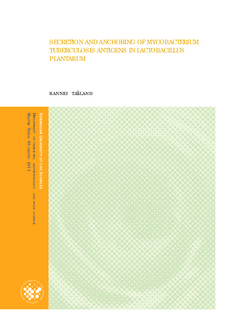| dc.description.abstract | The aim of this study was to develop the LAB Lactobacillus plantarum WCFS1 as a delivery-vehicle for a human vaccine against infection by Mycobacterium tuberculosis. Because lactic acid bacteria have a long record of safe oral consumption of lactic acid bacteria and are natural inhabitants of the human gastrointestinal tract, these bacteria are being extensively studied as potential vectors for production and in situ delivery of heterologous proteins. Lactobacillus plantarum WCFS1is an interesting candidate for this purpose due to its ability to survive the passage of the stomach and to persist in the human gastrointestinal tract for up to seven days. Mucosal immunity plays a major role in the prevention of infectious diseases, and the use of live bacterial vectors for mucosal delivery of therapeutic molecules have been successful in several studies using animal models.
In the present study, intracellular and extracellular production of Ag85B-ESAT6, a fusion protein consisting of two major antigens from Mycobacterium tuberculosis, was achieved in L. plantarum. Secretion was accomplished using homologous signal peptides from the genome of L. plantarum WCFS1. The secretion efficiency was found to vary depending of the signal peptide, thereby emphasising the value of evaluating several signal peptides when selecting a signal peptide for secretion of a heterologous protein. The Ag85B-ESAT6 fusion protein was also targeted for covalent cell wall-anchoring using a LPXTG anchor from L. plantarum. In addition attempts were made to anchor Ag85B-ESAT6 to the cell membrane through the anchoring domain of a L. plantarum lipoprotein. Analysis of the presence of antigens on the cell surface showed that the putatively cell membrane-anchored, cell wall-anchored and secreted version of Ag85B-ESAT6 were present in nearly equal amounts, leaving the question whether the anchors contribute to cell wall localisation somewhat non-conclusive. L. plantarum harbouring the various plasmids for production of Ag85B-ESAT6 or the empty vector (pSIP-EV) was all able to elicit a cytokine response when co-incubated with dendritic cells, indicating the ability of these recombinant strains and L. plantarum itself to provoke an immune response in a future host.
This thesis shows that L. plantarum WCFS1 is able to produce, secrete and likely anchor the M. tuberculosis fusion protein Ag85B-ESAT6, by utilising homologous signal peptides and anchors. The present results are promising with respect to use of L. plantarum as a vaccine delivery vector. | no_NO |
